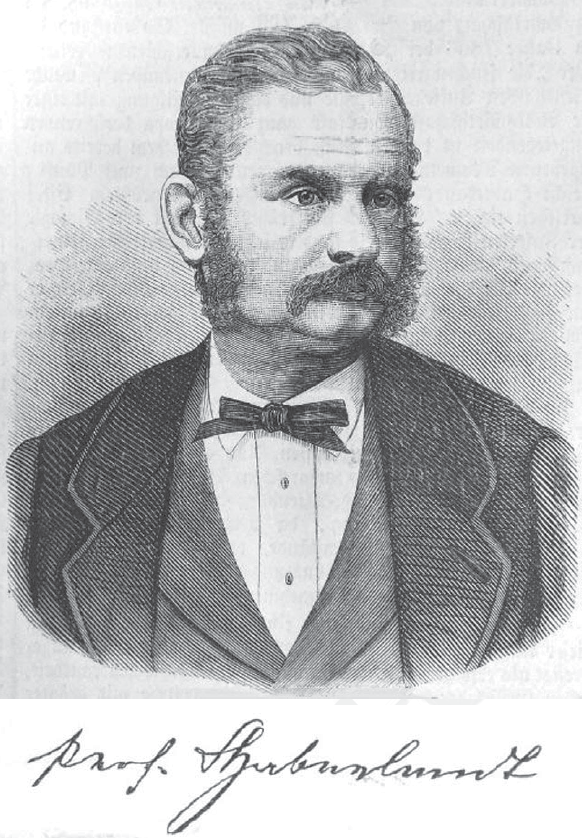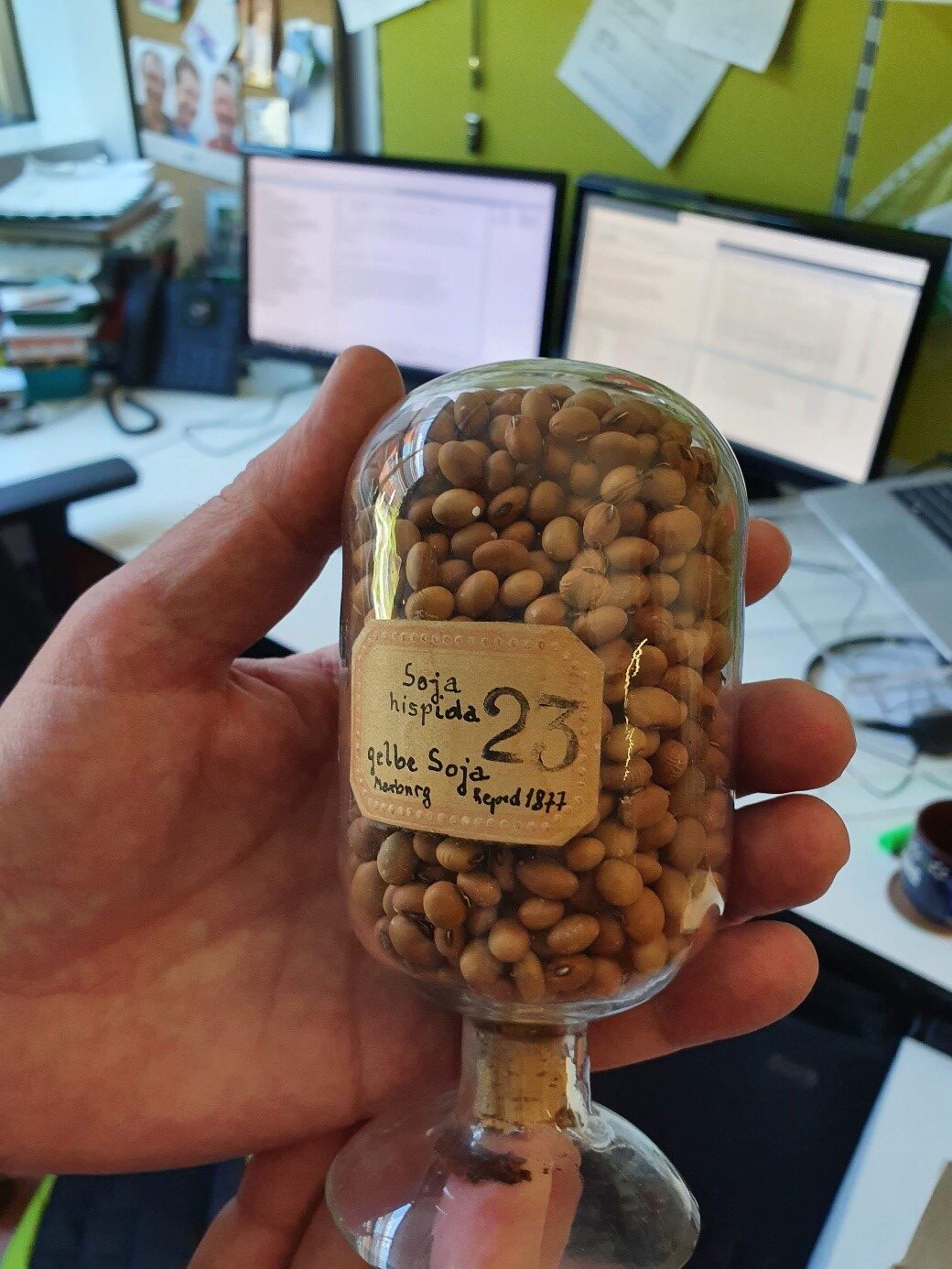
Friedrich Haberlandt and the soybean
In the course of the 19th century, natural scientists in Europe took notice of a “miraculous stranger”, a nutritious cultivated plant rich in fats and protein – the soybean. One of the most renowned soy pioneers was Friedrich Haberlandt, a 46-year-old botanist and agronomist from Pressburg [Brastislava] who had recently accepted a position as a Professor of Botany at the newly founded k. k. Hochschule für Bodenkultur (University of Natural Resources and Life Sciences) in Vienna. Haberlandt became acquainted with the soybean at the Vienna World’s Fair in 1873. The event had a decisive influence on both the representation and the perception of Japan and China in Austro-Hungary, leading to a rise in people’s interest in the Far East. The exposition’s showrooms presented the visitors with a myriad of curiosities from the Far East, among them seeds of the soy plant, which was up to this point unknown to most Europeans.
During his visit, Haberlandt acquired 20 samples of different soybean varieties from China, Japan, Mongolia, Transcaucasia, and Tunisia. Likely, Haberlandt was already acquainted with soy by then for he mentions a publication concerning the chemical composition of “Chinese oil beans” dating back to 1872. Haberlandt also composed an account of all the crops displayed at the world exposition, in which he highlights the importance of legumes in the Chinese and Japanese diets. He further mentions a bean from northern China, which has an exceptionally high amount of fat and is used for the production of oil and a “kind of cheese” (tofu).
Jacquin, Nikolaus Joseph v. – Icones plantarum rariorum. 1781-1793. Colorized copperplate printing.
Österreichische Nationalbibliothek.
Being fascinated by the exotic plant, Haberlandt decided to cultivate the acquired soy seeds in the experimental garden of the Vienna Hochschule für Bodenkultur in 1875. The trials delivered promising results and by using a relatively simple form of empirical breeding he succeeded in isolating the early-maturing varieties which proved to perform well under the climatic conditions. The yellow-colored seeds from Mongolia and China, as well as the red-brown from China, were especially fertile.
Haberlandt was enthusiastic about the soybean’s nutritional and agricultural potential. One of the main motives for his promotion campaign was the prospect of improving public nutrition and fighting malnutrition among the working class – a target similar to some of the soybean pioneers in the USA, who tried to introduce tofu and coagulated soymilk as mainstream food. In fact, US plant breeders started to experiment with different soybean varieties around the same time. One of them, James Nielsen of the New Jersey agricultural experiment station also visited the 1873’s world fair in Vienna and acquired various seed samples. He possibly even met Haberlandt since he frequently mentions his research in the following years. However, whereas the US Department of Agriculture soon got involved in soybean research, governmental support and commercial interest were lacking in the Habsburg Monarchy. It took the individual effort of scientists to promote and push the introduction of the new field crop.
Drawing of Friedrich Haberlandt (*1826 – †1878) including his signature.
Source: https://www.soyinfocenter.com/pdf/225/AuHu.pdf
From Vienna to all over Europe
Haberlandt was encouraged by the healthy growth of the early-maturing plants, thus he decided to continue experimenting with soybeans in the coming years. By 1877, the field trials already included 148 participants from all over Europe, creating headlines in agricultural journals and even daily newspapers. Soybeans reproduced in Vienna were now cultivated in the Croatian, Czech, Slovakian, Slovenian, Hungarian, and German-speaking parts of the Habsburg Monarchy, Germany, Italy, the Netherlands, Poland, Romania, Serbia, Switzerland, and the Ukrainian parts of the Russian Empire. Even though not all trials were successful, the general suitability of Haberlandt’s soybean varieties was proven for many regions in Central and Southeast Europe. Haberlandt finally published the collective trial results in his magnum opus “Die Sojabohne” in 1878. Sadly, Haberlandt did not live to see the success of his book, he died the same year.
With the early death of Haberlandt public and scientific interest in the soybean quickly faded. But scattered reports, inquiries, and advertisements show the continuous circulation of knowledge about the soybean during the following years, yet Haberlandt’s envisioned integration and expansion with “thousands of farmers producing far more than 1.000 tons of this unsurpassable bean” failed. The supervision of the implementation was too closely connected to one single person, the genetic resources were too narrow for commercial production, and it lacked governmental funding to completely acclimatize the seed material through systematic mass selection and cross-breeding. There were also no attempts to adopt Asian crop production or processing methods, even though the authors were aware of traditional practices and techniques.
A glass of yellow soybean seeds (soja hispida) from 1877. Soybean pioneer Friedrich Haberlandt probably received these samples from a colleague in Marburg (current day Maribor, Slovakia) who participated in one of Haberlandt’s field trails.
Source: photograph from personal collection.
From a technological point of view, the procedures of soy production had to be practically invented from scratch and did not permanently infiltrate the broad agricultural knowledge. However, Haberlandt’s results triggered a cascade of general interest in the soybean in the Western world, as his soybean varieties were distributed all around the globe, and several later developments built upon his findings and materials. In the USA for example, the soybean was incrementally integrated into the farming system as a rotation crop, accompanied by the establishment of an associated processing industry up until the Second World War. In Austro-Hungary, the soybean moved into the spotlight once again during the dire straits of World War One as an alternative source of oil protein. However, despite the first-time involvement of the government, the transfer of knowledge concerning the production, processing, and consumption of soybeans to wider parts of the population proved to be insurmountable. Only the oil crises and economic shifts of the 1970s brought a change and facilitated successful lasting soybean research and production in Austria.
In hindsight, the introduction of soybeans into Austria was a long and rocky road. But it all started in the late 19th century with the curiosity of a talented scientist, a couple of beans, and a small strip of soil in the 8th Vienna city district.
Maximilian Martsch is a researcher and PhD candidate at the Department of Social and Economic History at the Johannes Kepler University Linz, Austria. He is part of the research project “Soy and Agro-Food Change (SoyChange). Austria from a Multi-Level Perspective, c. 1870-2020s” funded by the Austrian Science Fund (FWF). After finishing his history degree at the University of Vienna, Maximilian was a visiting fellow at the University of Toronto and the Free University of Brussels. He was also involved in serval research projects, including an engagement at the Institute of Rural History in St. Pölten.




0 Comments